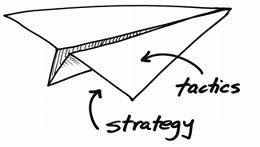
ISO 9001: Elevating Excellence in Quality Management
Quality Management ISO 9001 is an internationally recognized standard that plays a vital role in elevating excellence in quality management. In today’s highly competitive business
AKAP Accreditation Organization


There are quite a few differences between strategy and tactical planning. In short, strategic planning is used to set destination and how you are going to get there, and tactical planning outlines the specific actions you are going to take along the way. Below, we’ll expound on strategy vs tactics, the differences and similarities between the two, and explain how you can track the progress of each.
Strategy describes the destination and how you are going to get there, and tactics describe the specific actions you are going to take along the way.
About 2,500 years ago, Chinese military strategist Sun Tzu wrote “The Art of War.” In it, he said, “Strategy without tactics is the slowest route to victory. Tactics without strategy is the noise before defeat.” Tactics and strategy are not at odds with one another—they’re on the same team. (And they have been for many centuries!) Here’s how we define the tactical vs. the strategic:
A solid strategy reflects the core values of the organization. Your strategic team should gather input from across the organization to ensure there’s alignment between the strategy and each department’s priorities. All strategies should be actionable.
When creating a good strategy, focus on the desired end result (the goal). Your strategy is the foundation for all activities within the organization, and how it’s crafted will guide decision-making as your teams work to achieve those goals. For example, if a furniture company has a goal to expand market share, its strategy could include offering the most competitive prices and always being in stock of common offerings. Leadership teams will make decisions that prioritize lower costs.
A good tactic has a clear purpose that aids your strategy. It has a finite timeline during which specific activities will be completed and their impacts measured.
A tactic for the furniture company would be to analyze manufacturing processes to minimize waste and inefficiencies, thereby decreasing cost and, by extension, prices for customers. The company can clearly measure the success of the tactic by comparing their costs before and after the analysis.
Here are a few examples of how strategy and tactics interact that will help you differentiate between the two terms:
For the sake of example, let’s say your organization’s overarching mission is to reduce the carbon footprint that humans are contributing to. If your strategy is to reduce carbon emissions in a certain area by a certain percentage, one goal might be to educate people about the options available to them in regard to renewable energy. From there, you might decide one particular tactic to use would be a marketing campaign through television ads. From there, you’d track the resources you need for this project and begin checking off items like hiring a producer, writing your script, shooting your scenes, editing your video, and so forth.

Quality Management ISO 9001 is an internationally recognized standard that plays a vital role in elevating excellence in quality management. In today’s highly competitive business

What does SWOT stand for? SWOT stands for Strengths, Weaknesses, Opportunities, and Threats, and so a SWOT Analysis is a technique for assessing these four aspects of your